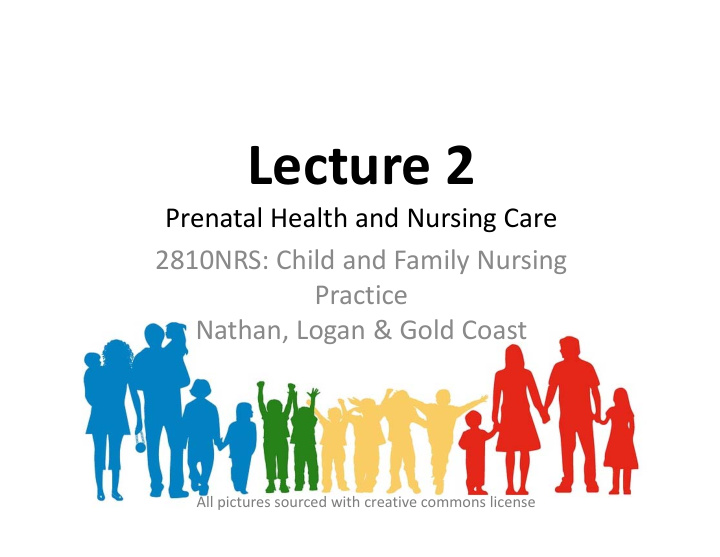



Lecture 2 Prenatal Health and Nursing Care 2810NRS: Child and Family Nursing Practice Nathan, Logan & Gold Coast All pictures sourced with creative commons license
In addition to viewing this lecture, please: Complete Online Course Content: ✔ Topic 2.1 Prenatal health Topic 2.2 Prenatal nursing care ✔ Complete “Prenatal” Case Study JTOOL ✔ Attend and participate in your seminar ✔ Complete required and/or recommended readings
By the end of this lecture, you should be able to: • Define the key aspects of health in the prenatal period, including contraception and preconception care; • Describe issues and challenges experienced by families in the prenatal period • Demonstrate an understanding of the functioning of families in the prenatal period using family assessment models that enable families to make health decisions.
Gestation Preconception Prenatal Perinatal Period Period Postnatal Neonate Period
Term Definition Preconception Time prior to woman becoming pregnant Prenatal period Also known as antenatal period, the period of pregnancy from conception to the onset of labour. Note: prenatal and antenatal are used synonymously throughout this module Gestation The number of weeks pregnant Perinatal period Period commencing at 20 completed weeks (140 days) of gestation and ending 28 completed days after birth Postnatal period The first six weeks after birth Neonate Another term used to denote the newborn in the first four weeks of life
• Aim is to identify and/or modify biomedical, behavioural and social risks • Screen for risks • Engage in health promotion and education • If risks are identified, intervene Ensure woman entering pregnancy is in good health which will optimise maternal and perinatal outcomes.
• First assessment occurs optimally within the first trimester • What to expect at first visit (Video) • In Australia – options of private and public maternity services – Public – Usually shared care with GP/midwives. – Private – Women choose obstetrician or privately practising midwife. • Need to establish good rapport through communication
• Should begin with preconception care • Usually 10 visits with health care provider for first pregnancy and no complications; 7 visits for subsequent uncomplicated pregnancies. • Consultations need to be planned on the family’s individualised needs.
• Identify issues or challenges that are, or may be experienced by the mother and family. • Goals can then be set to address these issues. • Health promotion can be provided How can nurses support women experiencing difficulties?
Lifestyle factors can contribute and have adverse effects on mother and baby: • Smoking including exposure to passive smoke • Drinking alcohol • Use of illicit drugs • Nutrition
WHO’s vision every pregnant woman and newborn receives quality care National Evidence ‐ Based Antenatal Care Guidelines Family and Domestic Violence Strategy 2016 ‐ 2019 The National Maternity Services Plan National Maternity Services Plan 2014 –2015 Annual Report
• Continuity of care should be fundamental aspect of maternity service models • Preconception care helps prevent adverse outcomes • Implementation in preconception care should include a range of areas
• Ongoing process • Have the goals been met? • Has the health care provided been effective? • Does the mother and family have the information to make appropriate choices?
You should now be able to: • Describe health, issues and challenges experienced by families in the prenatal period • Demonstrate an understanding of the functioning of families in the postnatal period using family assessment models that enable families to make health decisions; • Delineate the key aspects of assessing, planning, implementing and evaluating postnatal care
Australian Health Ministers’ Advisory Council 2012, Clinical Practice Guidelines: Antenatal Care – Module 1 . Australian Government Department of Health and Ageing, Canberra. http://www.health.gov.au/antenatal Sexual Health & Family Planning Australia. (2013). Contraception choices . Retrieved from http://familyplanningallianceaustralia.org.au/wp ‐ content/uploads/2015/08/Contraceptive ‐ Choices ‐ factsheet.pdf World Health Organization (WHO). (2013). Preconception care to reduce maternal and childhood mortality and morbidity. Retrieved from http://apps.who.int/iris/bitstream/10665/78067/1/9789241505000_ eng.pdf?ua=1 World Health Organization (WHO). (2016a). Maternal and perinatal health. Retrieved from http://www.who.int/maternal_child_adolescent/topics/maternal/m aternalperinatal/en/
Recommend
More recommend